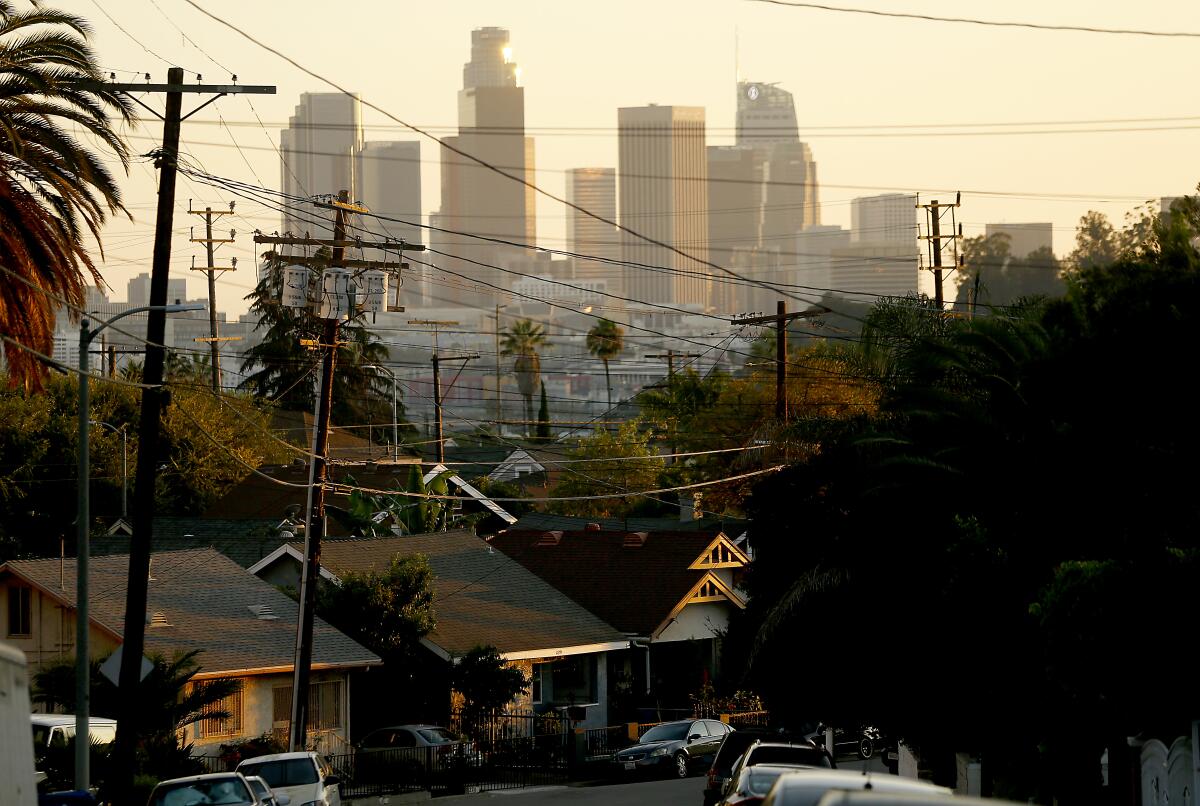‘L.A. trees are kicking ass.’ Urban plants capture more CO2 than expected, study finds

- Share via
Good morning. Here’s what you need to know to start your day.
- Study finds urban plants capture more CO2 than expected.
- His impressive basement saloon was like ‘Cheers’ — until it burned in the Eaton fire.
- Adults-only hotels are all over California. Are they even legal?
- And here’s today’s e-newspaper.
You're reading the Essential California newsletter
The most important California stories and recommendations in your inbox every morning.
You may occasionally receive promotional content from the Los Angeles Times.
Give it up for Los Angeles’ urban trees
A new study found they’re surprisingly good at absorbing the carbon dioxide we spew into the air with all our cars, energy consumption and corporate industrialization.
Researchers from USC’s Dornsife College of Letters, Arts and Sciences published their findings in the journal “Environmental Science & Technology” last month.
Using an array of sensors set up across a swath of central L.A., the team tracked CO2 emissions during an 18-month period. Over the course of a year, trees absorbed up to 60% of CO2 emissions on average during daytime, according to the study — significantly more than expected.
“That’s a huge number,” said Will Berelson, an earth sciences professor at USC who led the study. His initial reaction to the data wasn’t quite scientific enough to include in the journal, but I think it works just fine for this newsletter:
“Wow … L.A. trees are kicking ass.”

All aboard the CO2 Express
Berelson’s team approached the measurements similar to how a transit agency would measure ridership. That was possible, he explained, because of L.A.’s predominant wind, which moves from west to east, taking CO2 along for the ride.
Using a dozen sensors, researchers tracked this CO2 Express across a roughly 30-square-mile section of the city, from about La Brea Avenue between 3rd Street and Obama / Exposition Boulevard and northeast into Boyle Heights and Lincoln Heights neighborhoods.
“We’re actually watching as the air is moving across the city,” Berelson told me. “We’re seeing the change happening before our very eyes with these sensors — what’s happening on the west side and then towards the middle of the city and then farther to the east side — we can actually see changes as the air is passing.”
The data showed decreases in CO2 that indicated trees in the area were capturing up to 60% of emissions on average during daytime (trees and vegetation only absorb CO2 during photosynthesis, which requires sunlight). That works out to about 30% on average in a full 24-hour day, Berelson noted.

What actions could the research help inform?
Berelson is hopeful the model could be used by other cities looking to track and reduce CO2 emissions.
He was also surprised how much CO2 trees in the area were able to capture, considering “this is a part of L.A. that doesn’t really strike you as being all that green.”
That lack of trees has been an ongoing challenge in the city, with studies finding stark disparities in which communities experience the benefits trees provide through shade, heat mitigation and cleaning the air.
Berelson said expanding on this study could help L.A. and other cities “be quantitative [and] scientific about how we plan tree planting.”
And while urban trees have demonstrated an “uncanny ability to take up a lot of CO2 quickly,” he emphasized that just planting a lot more trees isn’t a singular solution to the region’s air quality and climate crises.
“Emission reduction has to happen,” Berelson said.
More tree studies are in the works
A greenhouse study is underway at USC to see which species of trees capture the most carbon, which Berelson said has been “fascinating” so far.
“We actually have to take a careful look at what types of trees we’re planting, because it can make a big difference … in terms of how much CO2 we can take up,” he said.
That study will also analyze how trees are affected by a warming climate, which Berelson said will affect CO2 uptake.
And while this initial study area included major freeway intersections (including the 10, 110 and 5) it did not take a granular look at emissions near those emission-heavy roadways. Berelson’s team will work to parse the data moving forward, he told me.
The researchers also recently installed more sensors on each end of the initial study area, giving them “a longer train to look at,” Berelson said.
Those follow-up studies are likely a year or more away, so stay tuned!
Today’s top stories

These California coastal cities face heightened flood danger from a tsunami, data show
- A large tsunami could flood swaths of Marina del Rey, Long Beach and the nearby dual port complex to an elevation of up to 15 feet above sea level.
- A worst-case tsunami could bring flooding to sizable areas of Oakland, Berkeley and Alameda, up to 18 feet above sea level.
- But for most Californians, the precise extent of tsunami risk is less important than knowing hazard zones exist in the first place.
Newsom asks the California Legislature for another $2.8 billion to cover Medi-Cal cost overruns
- The request comes days after he told lawmakers that he took out a separate $3.4-billion loan to pay for Medi-Cal costs through March.
- Medi-Cal costs are billions over estimates from last summer at a time when California is experiencing higher than expected costs for expanding coverage to undocumented immigrants, greater enrollment and rising pharmacy expenses for the program.
A California bill would restore wetlands protections in wake of Supreme Court ruling
- State lawmakers are proposing legislation that aims to reestablish safeguards for the state’s streams and wetlands in response to a Supreme Court ruling limiting federal clean water regulations.
- Supporters say the legislation has taken on heightened urgency as the Trump administration begins to scale back protections for many streams and wetlands, making them vulnerable to pollution and worsening water quality.
What else is going on
- L.A. touts success at blocking tee time brokers from city golf courses.
- Elon Musk’s team targets nearly two dozen environmental offices for closure in California.
- Their corporate landlord kicked them out to fix their flood-prone home, a lawsuit says. Instead, it was sold.
- The mayor and LAPD chief tout data that show homicides and shootings are on the decline.
- Covering disaster from the inside: Pali High journalists face their own story.
- Supreme Court Justice Roberts rejects Trump’s call for impeaching a judge who ruled against his deportation plans.
- Kink and rough sex are at the heart of a rape case against an actor.
- Newly declassified JFK assassination files have been released by the Trump administration.
- A man was detained after reportedly biting and striking other passengers on a flight bound for LAX.
Get unlimited access to the Los Angeles Times. Subscribe here.
Commentary and opinions
- Yes, Newsom’s new podcast is cringe, columnist Anita Chabria writes. But is it also smart?
- Sen. Alan Simpson’s legacy was tainted by his attacks on Social Security, columnist Michael Hiltzik writes.
This morning’s must reads

His impressive basement saloon was like ‘Cheers’ — until it burned in the Eaton fire. Before the January fires came, Brian Gardner had 300 Polaroids on the wall of his basement saloon, the Hye West Saloon of Santa Poco. He had over 1,000 bottles of booze too. But the Polaroids he hung around the perimeter of the 300-square-foot bar nestled in a storage room under some stairs at his Altadena home were more important to him.
Other must reads
- Why fans are still coming to ‘The Office’ 20 years later.
- A vintage shop turned community hub in Boyle Heights fights to survive.
How can we make this newsletter more useful? Send comments to [email protected].
For your downtime

Going out
- 🏨 Adults-only hotels are all over California. Are they even legal?
Staying in
- For Ellen Pompeo and Mark Duplass, trust was central to ‘Good American Family’ — now streaming on Hulu.
- 🥦 Here’s a recipe for broccoli-fennel soup with garlic croutons.
- ✏️ Get our free daily crossword puzzle, sudoku, word search and arcade games.
A question for you: What’s your favorite California book?
Victoria Loch writes: “‘The Long Goodbye’ by Raymond Chandler. As a born and bred NYer and long time Californian, this is the essence of the state (and state of mind) to me. Less convoluted than ‘The Big Sleep,’ this captures all the glory and sadness and insanity that is California.”
Email us at [email protected], and your response might appear in the newsletter this week.
And finally ... your photo of the day
Show us your favorite place in California! Send us photos you have taken of spots in California that are special — natural or human-made — and tell us why they’re important to you.

Today’s great photo is from Times photographer Genaro Molina at the site of Diane and Verne’s Altadena home where they lived for 50 years. It was destroyed in the Eaton fire, and they are determined to rebuild it as a legacy gift to their family.
Have a great day, from the Essential California team
Ryan Fonseca, reporter
Defne Karabatur, fellow
Andrew Campa, Sunday reporter
Kevinisha Walker, multiplatform editor
Hunter Clauss, multiplatform editor
Christian Orozco, assistant editor
Stephanie Chavez, deputy metro editor
Karim Doumar, head of newsletters
Check our top stories, topics and the latest articles on latimes.com.
Sign up for Essential California
The most important California stories and recommendations in your inbox every morning.
You may occasionally receive promotional content from the Los Angeles Times.




